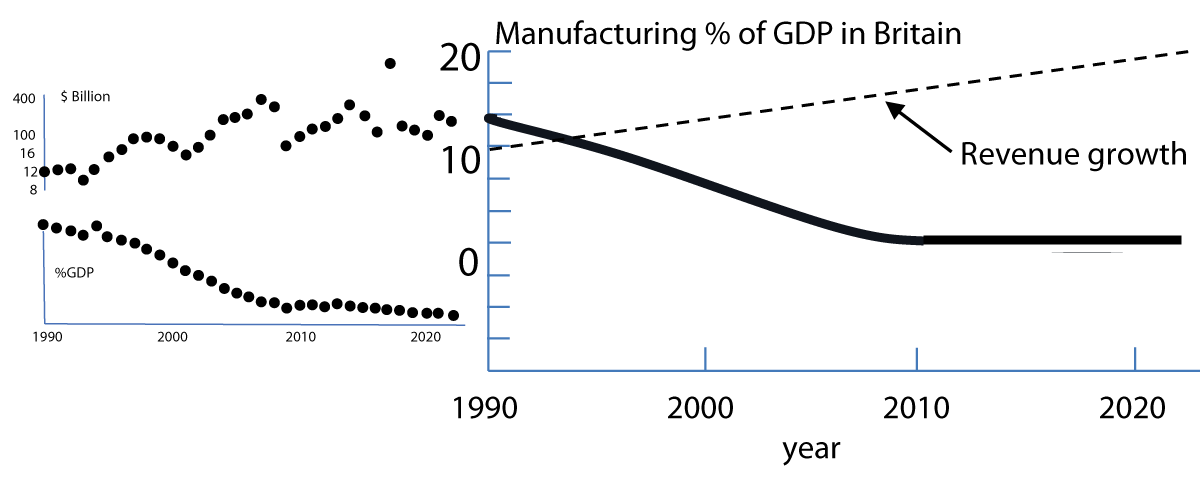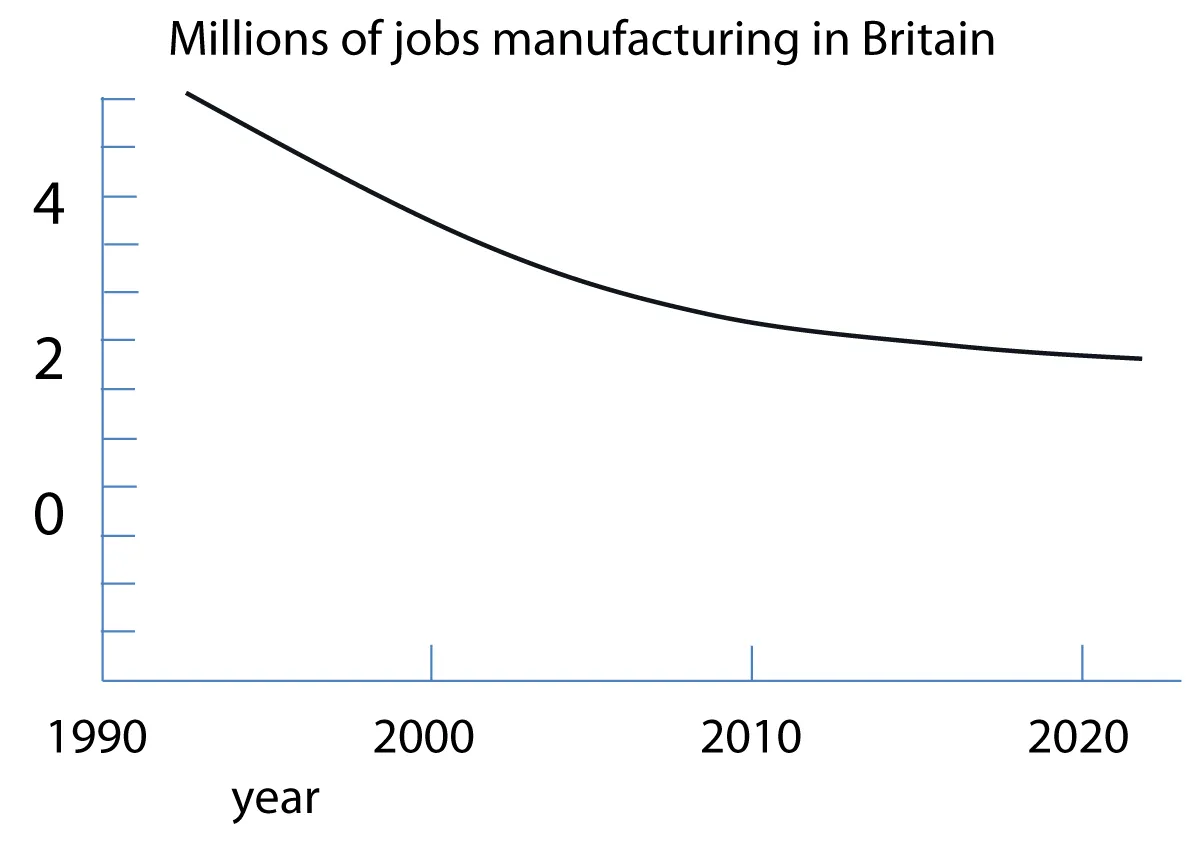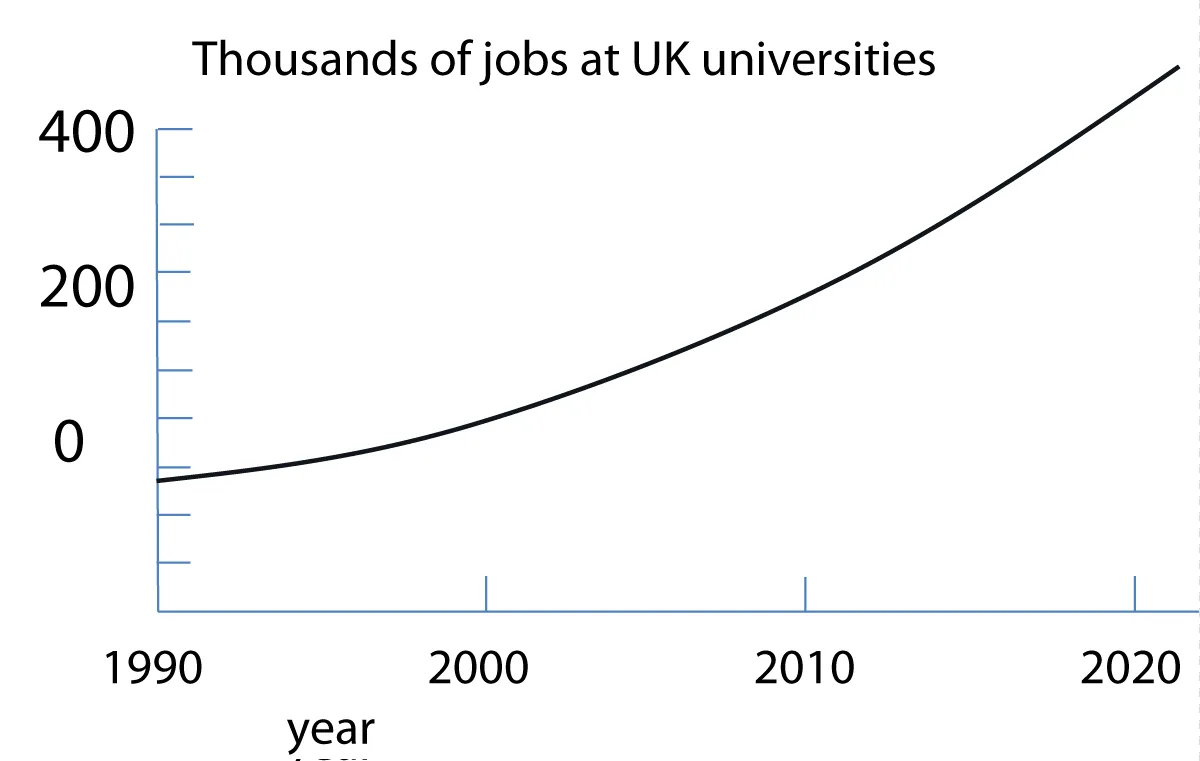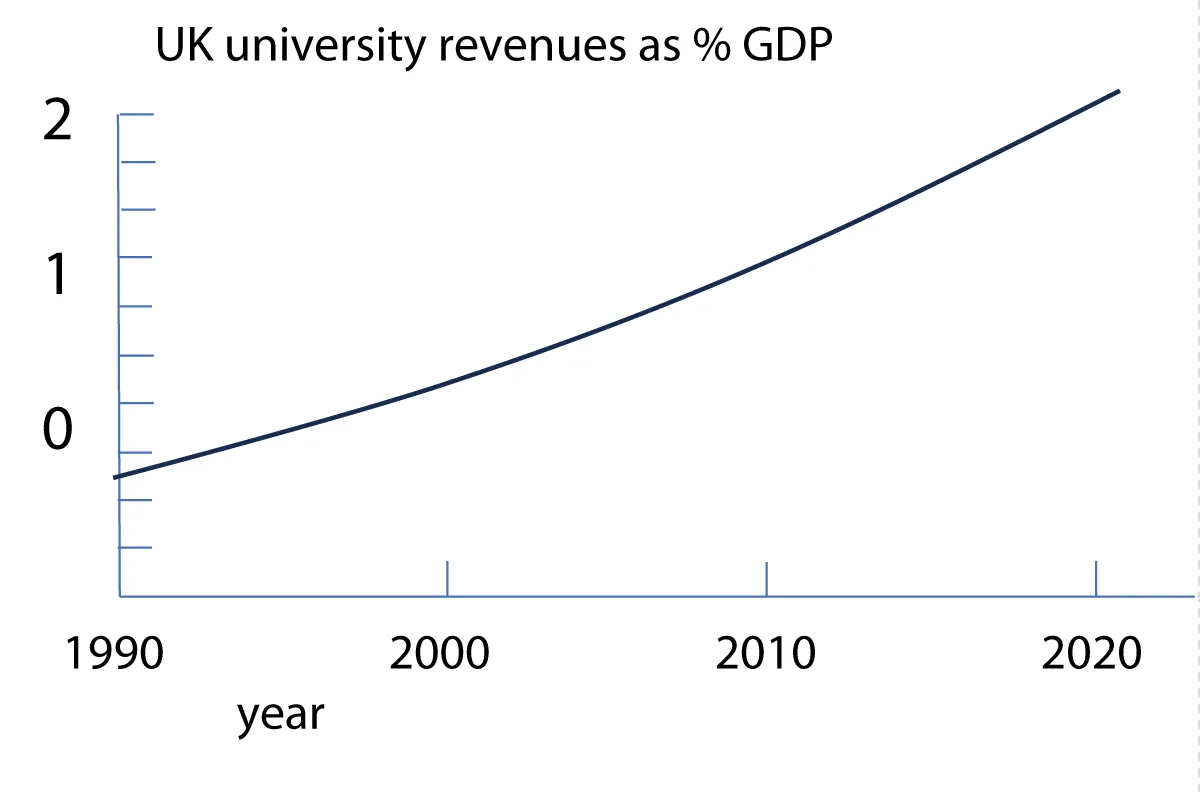
The University Sector is Converging on Manufacturing in UK
Educational Technology Industrial EngineeringAutomation and Control SystemsEducational Science受け取った 09 Feb 2024 受け入れられた 23 Feb 2024 オンラインで公開された 26 Feb 2024
ISSN: 2995-8067 | Quick Google Scholar
Next Full Text
Efficacy of Different Concentrations of Insect Growth Regulators (IGRs) on Maize Stem Borer Infestation


受け取った 09 Feb 2024 受け入れられた 23 Feb 2024 オンラインで公開された 26 Feb 2024
Many UK inhabitants now adopt careers working in both university and manufacturing sectors. In a typical engineering career, a young student may now start at university, spend time in factories, often in research and development, and then return to university in later life to teach evolving innovation principles of industry. It is clear to such people that universities are expanding rapidly whereas manufacturing has declined and reached an equilibrium of output but with lower job numbers due to robotics. Manufacturing in 2022 was approximately 8% of British GDP whereas the university sector was only about 2%. This paper analyses the growing connections and co-locations with numerous universities/manufacturing companies, predicting that convergence in both jobs and GDP contribution will occur around 2050.
A great example of collaboration between university and industry is Sir Isaac Newton who spent 30 years at the National Mint manufacturing coins, approximately the same period he lived in Cambridge University innovating mathematics and creating his laws of gravitation, motion, and viscosity. In the 17th century, it was difficult to work at universities because there were only 7 then, and not many jobs, but now many UK people find it easy to follow Newton’s line because there are 166 universities and a quarter million academic jobs in the UK. As an example, this author worked 30 years in industry and 30 years in academia [].
In 1985 a paper [] suggested that stronger links were needed between university and industrial sectors, especially to increase the R&D activities but also to interact in all kinds of cooperation. Restrictions that universities laid on staff members (for example Professor Newton was not allowed to marry) inhibiting industry participation at that time, were to be removed, while greater interactions at all levels were to be encouraged. Nowhere did that paper suggest that the 51 universities of 1985 might grow bigger than the thousands of UK manufacturing companies at that time. More recently, papers reveal that current students may be rejecting universities, preferring to move directly into industries at age 18 [] because they know industries are strongly connected to campuses. The purpose of this paper is to measure connections between UK universities and manufacturing, with the start of co-location for factories on university campuses, and convergence in economic size by 2050.
The University sector in Britain began almost 850 years ago as a small monastic grouping in Oxford while manufacturing at that time was a cottage industry making homes, food, textiles, leather goods, and products in wood and metals derived from mining. When UK manufacturing surged in the 18th to 20th centuries, Universities also expanded to train young people in the necessary skills. In Birmingham, for example, a university was founded at Edgbaston in 1900 to study manufacturing bread and beer while sending students down tunnels to learn about mining coal and other minerals, but also strongly based on medicine, mathematics, chemistry, and other academic subjects. Now that Universities have created industry parks, where innovative manufacturing can thrive while supplying young talent trained on-site, universities have generated more revenues and jobs than expected. In addition, many universities have expanded overseas to become international institutions that are increasing output further. During the same period, manufacturing has been declining in the UK and in most other countries as service sectors have gained popularity. The question is ‘When will universities economically match the manufacturing sector by converging predictably over time’.
The concept that UK manufacturing is declining has been fully accepted since Mrs Thatcher decided to sack 200,000 coal miners in 1984 []. Yet, methods for quantifying the changes in manufacturing need to be defined, especially because this decline is often quoted [-]. It can be traced back to the peak of about 8 million UK manufacturing jobs in 1952, when manufacturing was a third of the British economy, falling to around 4 million workers in the year 2000. By the same token, it is evident that UK universities have become more numerous in our lifetime, an order of magnitude increase since 1950 [], having 2.86 million students in 2022, with increasing revenues, also expanding into science parks and overseas to Asia, Africa, and Americas, with on-line web courses rising strongly. Therefore, a key question is the rate of UK convergence of these university and manufacturing sectors, accounting for inflation and other problems.
This paper compares 32 years of university and manufacturing converging in revenues and jobs, then extrapolates to predict future co-location, using annual data for revenues and employees. The purpose is to formalize the observed integration process and to understand how it will develop in the future.
The total gross domestic product (GDP) of manufacturing in Britain is confusing because numbers might differ by a factor of more than 2. For example, Make UK [] suggests a figure of £183bn for 2022 whereas the Government figure is £430bn []. It all depends on what counts as a manufactured product. For example, the government includes water as a manufactured product, a strange idea. Also, waste is called manufacturing too, but it does not seem sensible to manufacture waste. Therefore, we adopt the MakeUK method of classifying manufacturing sectors which are in alphabetical order: Chemicals/Pharms; Electric devices; Electronics; Food; Machinery; Metals; Polymers/non-metals; Vehicles; and Other manufacturing.
Then the key issue is the effect of inflation and other financial changes over the study period of thirty to forty years, found in []. These results in Figure 1 were interesting because the manufacturing revenues rose with time, showing noisy fluctuations whereas the contribution to UK GDP was smoother, declining from 16% in 1990 to 8% in 2022. The smoothed curves shown in Figure 1 show the trends more clearly. Although the smoothed manufacturing output may seem to rise by 50% shown in Figure 1 right as a broken line, it is evident from the bold curve that the manufacturing percentage of UK GDP (United Kingdom Gross Domestic Product) has fallen consistently with time, leveling out around 2009. The conclusion is that we should be normalizing the manufacturing revenues using the total GDP each year to smooth and define manufacturing decline compared to performance in other sectors.
 Figure 1: Left: Original data from []; right: Smoothed plot of UK manufacturing output as a percentage of total GDP each year compared to rising revenues shown as broken line.
Figure 1: Left: Original data from []; right: Smoothed plot of UK manufacturing output as a percentage of total GDP each year compared to rising revenues shown as broken line.Looking further back in time, the UK manufacturing output percentage fell significantly during the 20th century, dropping from 27% of the UK GDP in 1950. But it appears from Figure 1 right that the manufacturing contribution to GDP has now bottomed out and could remain constant at around 8.2% until 2050.
Another measure of manufacturing decline is the number of workers engaged through time [], shown in Figure 2. The number of manufacturing workers dropped from 4.4 million in 1992 to 2.7 million in 2022, suggesting a further drop to 1.6 million could be seen by 2050. Since manufacturing has advanced further towards robotic automation, this sector is now using high-level engineers to design robots rather than using laborers to assemble components by hand. So, job numbers will fall but rise in quality, while production may remain almost constant as in Figure 1.
The inexorable rise of universities, shown by the rapidly growing number of institutions smoothed in Figure 3 [], contrasts sharply with the decline in UK manufacturing companies, output, and jobs over recent years. The creation of numerous new universities during both the 1960s and 1990s seemed massive, but the period since the millennium has introduced 63 more, which is quite stunning. And student numbers continue to rocket, reaching a record number of 2.86 million in 2021-22.
Such an increase in student numbers requires more staff, so the job numbers in this sector have risen too, as shown in Figure 4, which includes admin workers, gardeners, and other employees on campus, approximately equal in number to academic staff.
Most importantly, the revenue from UK universities has risen rapidly as a proportion of the UK GDP, as shown in Figure 5. It is claimed that this high financial output creates a further 382,000 jobs indirectly in the communities around the university campus towns [], providing meals, residences, and other services, almost doubling employment locally and producing revenues near £116bn to the numbers in Figure 5. But this must not be added because these jobs are in the service sectors quite different from the education field, falling under a separate heading in the GDP list.
Other financial contributions are made by universities setting up overseas extensions of their UK establishments []. For example, the University of Birmingham opened its Dubai campus in 2018 and attracted up to 4500 students from different countries, only 20% from the Emirates. Not long ago, it was necessary for a student to live near Edgbaston to qualify for a Birmingham degree, but now Split Location is allowed in the regulations. As the Edgbaston campus expanded fourfold from the original 100 hectares in Selly Oak, with the 1951 Shakespeare Institute, for example, in Stratford upon Avon and others, this rule was changed. In Dubai International Academic City, Birmingham joined 30 other International Universities in teaching and research.
The University of Nottingham was the first to set up an overseas campus, first in Malaysia in 1999 and another Ningbo in China in 2004. Over 55 UK universities now have an overseas presence with thousands of staff and more than half a million students. Oxford Brookes alone has about 300,000 students studying for an accountancy degree overseas. This foreign student market is increasing and brings in about £ 26 billion in export revenues, around 20% of university fees income, but the offshore campus return is only 4% of total tuition income [] yet attracts many thousands of students to study in the UK.
The main purpose of this paper is to predict the next 30 years of convergence from the last 30 years, using the data in Figures 1,2, 4 and 5. The trends are not simple and have been estimated using a geometric principle.
Two methods for judging the fall of manufacturing and the rise of universities can be seen in Figures 1-5. The simplest is comparing the job numbers, while the second method plots the percentage of UK GDP emerging from the two sectors.
Jobs in universities have risen by a factor of 4 in 30 years, and at that rate would predict 1.6 million by 2050, whereas manufacturing jobs have fallen by a factor of 0.58 in the same period, also suggesting 1.6 million by 2050 where crossover could occur. Figure 2 shows a drop in manufacturing jobs that may be slowing over the last 5 years, but that change in the curve is difficult to model, so the geometric ratio has been adopted.
University revenues relative to UK GDP have also risen by a factor of 4 in 32 years to 2022. That rate suggests the 2050 fraction of GDP would be 8.4% for universities, whilst the leveling of the curve for manufacturing in Figure 1 suggests that revenues will remain constant from now on at 8.2% of GDP. The prediction of convergence by this method is consistent with full convergence arising slightly before 2050.
An interesting coincidence is that Sheffield University has constructed a new building called Factory 2050, based on campus but next to the business park where Rolls Royce, Boeing, and McLaren have development factories []. So, convergence predicted in 1985 [] has already been seen in the co-location of university/industry factories in Sheffield, but now explicitly defining 2050 as the target year.
Internationally, a similar convergence of industries and Universities has been observed recently, especially in China which has been advancing rapidly on both fronts [-].
The contributions of both manufacturing and university sectors to the UK economy have been compared and contrasted.
Manufacturing shows a decline, especially in jobs, but production may stay high because robots are taking over manual labor, which is now disappearing, leaving high-quality engineering jobs to create futuristic autonomous factories. Universities in Britain are expanding at an increasing rate. There are now eight times more universities than existed in 1950, more jobs, and revenues rising rapidly. This may hit a bottleneck because 50% of UK children are now attending universities, but 20% of income is currently brought in by overseas students and by offshore campuses, starting in the last 20 years and establishing many courses for different countries, such that millions of new students may still be accessed abroad in future, keeping growth alive.
Two methods for assessing the decline of manufacturing versus the rise of universities have been analyzed. First is the jobs number in each sector, changing year on year; second is the percentage contribution of revenues to UK GDP which has fallen for manufacturing but is rising rapidly for universities. Both methods lead to the conclusion that the university sector will fully converge with manufacturing around 2050.
Kevin Kendall. https://en.wikipedia.org/wiki/Kevin_Kendall
Galvin EP. Industry and University: Paths that must converge. European Journal Engineering Education. 1985; 10:119-125.
Burgess N. The disposition and tactics of school sixth-formers who reject the institutional ‘push’ to university. Journal of Education and Work. 2023. 36(6): https://doi.org/10.1080/13639080.2023.2254255
Capstick K. Unlike Margaret Thatcher, miners believed in society. Guardian. 2013.
Narwan G. Decline in manufacturing at lowest pace for a year. Times. 2020.
Tomlinson J. Deindustrialisation and ‘Thatcherism’: moral economy and unintended consequences. Contemporary British History. 2021; 35(4): 620-642. https://doi.org/10.1080/13619462.2021.1972416
Benedetto J. Trends in Manufacturing Employment in the Largest Industrialized Economies during 1998-2014. USITC Executive Briefings on Trade, April. Washington, DC: U.S. International Trade Commission. 2018.
Society Education & Science. Higher education in the UK - Statistics & Facts. https://www.statista.com/topics/6938/higher-education-in-the-uk/topicoverview
Uk Manufacturing The Facts: 2022. https://www.makeuk.org/insights/publications/uk-manufacturing-the-facts-2022
Manufacturing and production industry. Cenus. 2021. https://www.ons.gov.uk/businessindustryandtrade/manufacturingandproductionindustry
K. Manufacturing Output 1990-2024. https://www.macrotrends.net/countries/GBR/united-kingdom/manufacturing-output
Manufacturing: statistics and policy. https://researchbriefings.files.parliament.uk/documents/SN01942/SN01942.pdf
A-Z list of 166 Universities in the United Kingdom | uniRank (4icu.org)
UniversitiesUK, Call to back universities as report reveals £116 billion contribution to UK economy , news, 7 sept 2023, https://www.universitiesuk.ac.uk
Bennell P. Financial returns to onshore and offshore overseas students at British universities Int J Educational Devt. 2019; 70: 102097
Allcock A. Profound Transformation. Machinery. 2018. https://www.machinery.co.uk/content/features/profound-transformation
Xiao H, Cui X. Impact of industry-university-research collaboration and convergence on economic development: Evidence from Chengdu-Chongqing economic circle in China. Helyon. 2023; 9:
Rybnicek R, Königsgruber R. What makes industry–university collaboration succeed? A systematic review of the literature. J Bus Econ. 2019; 89: 221–250. https://doi.org/10.1007/s11573-018-0916-6
Yu Z. One Case of THOUGHT: Industry-University Converged Education Practice on Open Source. In: Hong W, Weng Y. (eds) Computer Science and Education. ICCSE 2022. Communications in Computer and Information Science. Springer, Singapore. 2023; 1813. https://doi.org/10.1007/978-981-99-2449-3_26
Kendall K. The University Sector is Converging on Manufacturing in UK. IgMin Res. 26 Feb, 2024; 2(2): 139-142. IgMin ID: igmin156; DOI: 10.61927/igmin156; Available at: www.igmin.link/p156
次のリンクを共有した人は、このコンテンツを読むことができます:
Address Correspondence:
Kevin Kendall, 56 Harborne Road, Birmingham B15 3HE, No. 234992774, UK, Email: [email protected]
How to cite this article:
Kendall K. The University Sector is Converging on Manufacturing in UK. IgMin Res. 26 Feb, 2024; 2(2): 139-142. IgMin ID: igmin156; DOI: 10.61927/igmin156; Available at: www.igmin.link/p156
Copyright: © 2024 Kendall K. This is an open access article distributed under the Creative Commons Attribution License, which permits unrestricted use, distribution, and reproduction in any medium, provided the original work is properly cited.
![Left: Original data from [11]; right: Smoothed plot of UK manufacturing output as a percentage of total GDP each year compared to rising revenues shown as broken line.](https://www.igminresearch.jp/articles/figures/igmin156/igmin156.g001.webp) Figure 1: Left: Original data from [11]; right: Smoothed plo...
Figure 1: Left: Original data from [11]; right: Smoothed plo...
 Figure 2: Fall in the number of UK manufacturing jobs over t...
Figure 2: Fall in the number of UK manufacturing jobs over t...
![Increasing number of UK universities recently [13] (all curves are smoothed).](https://www.igminresearch.jp/articles/figures/igmin156/igmin156.g003.webp) Figure 3: Increasing number of UK universities recently [13]...
Figure 3: Increasing number of UK universities recently [13]...
 Figure 4: Academic plus supporting jobs at UK universities (...
Figure 4: Academic plus supporting jobs at UK universities (...
 Figure 5: Revenues of UK universities as a proportion of GDP...
Figure 5: Revenues of UK universities as a proportion of GDP...
Kevin Kendall. https://en.wikipedia.org/wiki/Kevin_Kendall
Galvin EP. Industry and University: Paths that must converge. European Journal Engineering Education. 1985; 10:119-125.
Burgess N. The disposition and tactics of school sixth-formers who reject the institutional ‘push’ to university. Journal of Education and Work. 2023. 36(6): https://doi.org/10.1080/13639080.2023.2254255
Capstick K. Unlike Margaret Thatcher, miners believed in society. Guardian. 2013.
Narwan G. Decline in manufacturing at lowest pace for a year. Times. 2020.
Tomlinson J. Deindustrialisation and ‘Thatcherism’: moral economy and unintended consequences. Contemporary British History. 2021; 35(4): 620-642. https://doi.org/10.1080/13619462.2021.1972416
Benedetto J. Trends in Manufacturing Employment in the Largest Industrialized Economies during 1998-2014. USITC Executive Briefings on Trade, April. Washington, DC: U.S. International Trade Commission. 2018.
Society Education & Science. Higher education in the UK - Statistics & Facts. https://www.statista.com/topics/6938/higher-education-in-the-uk/topicoverview
Uk Manufacturing The Facts: 2022. https://www.makeuk.org/insights/publications/uk-manufacturing-the-facts-2022
Manufacturing and production industry. Cenus. 2021. https://www.ons.gov.uk/businessindustryandtrade/manufacturingandproductionindustry
K. Manufacturing Output 1990-2024. https://www.macrotrends.net/countries/GBR/united-kingdom/manufacturing-output
Manufacturing: statistics and policy. https://researchbriefings.files.parliament.uk/documents/SN01942/SN01942.pdf
A-Z list of 166 Universities in the United Kingdom | uniRank (4icu.org)
UniversitiesUK, Call to back universities as report reveals £116 billion contribution to UK economy , news, 7 sept 2023, https://www.universitiesuk.ac.uk
Bennell P. Financial returns to onshore and offshore overseas students at British universities Int J Educational Devt. 2019; 70: 102097
Allcock A. Profound Transformation. Machinery. 2018. https://www.machinery.co.uk/content/features/profound-transformation
Xiao H, Cui X. Impact of industry-university-research collaboration and convergence on economic development: Evidence from Chengdu-Chongqing economic circle in China. Helyon. 2023; 9:
Rybnicek R, Königsgruber R. What makes industry–university collaboration succeed? A systematic review of the literature. J Bus Econ. 2019; 89: 221–250. https://doi.org/10.1007/s11573-018-0916-6
Yu Z. One Case of THOUGHT: Industry-University Converged Education Practice on Open Source. In: Hong W, Weng Y. (eds) Computer Science and Education. ICCSE 2022. Communications in Computer and Information Science. Springer, Singapore. 2023; 1813. https://doi.org/10.1007/978-981-99-2449-3_26